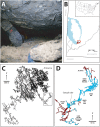High Microbial Diversity Despite Extremely Low Biomass in a Deep Karst Aquifer
- PMID: 30534116
- PMCID: PMC6275181
- DOI: 10.3389/fmicb.2018.02823
High Microbial Diversity Despite Extremely Low Biomass in a Deep Karst Aquifer
Abstract
Despite the importance of karst aquifers as a source of drinking water, little is known about the role of microorganisms in maintaining the quality of this water. One of the limitations in exploring the microbiology of these environments is access, which is usually limited to wells and surface springs. In this study, we compared the microbiology of the Madison karst aquifer sampled via the potentiometric lakes of Wind Cave with surface sampling wells and a spring. Our data indicated that only the Streeter Well (STR), which is drilled into the same hydrogeologic domain as the Wind Cave Lakes (WCL), allowed access to water with the same low biomass (1.56-9.25 × 103 cells mL-1). Filtration of ∼300 L of water from both of these sites through a 0.2 μm filter allowed the collection of sufficient cells for DNA extraction, PCR amplification of 16S rRNA gene sequences, and identification through pyrosequencing. The results indicated that bacteria (with limited archaea and no detectable eukaryotic organisms) dominated both water samples; however, there were significant taxonomic differences in the bacterial populations of the samples. The STR sample was dominated by a single phylotype within the Gammaproteobacteria (Order Acidithiobacillales), which dramatically reduced the overall diversity and species richness of the population. In WCL, despite less organic carbon, the bacterial population was significantly more diverse, including significant contributions from the Gammaproteobacteria, Firmicutes, Chloroflexi, Actinobacteria, Planctomycetes, Fusobacter, and Omnitrophica phyla. Comparisons with similar oligotrophic environments suggest that karst aquifers have a greater species richness than comparable surface environs. These data also demonstrate that Wind Cave provides a unique opportunity to sample a deep, subterranean aquifer directly, and that the microbiology of such aquifers may be more complex than previously anticipated.
Keywords: aquifer; bacteria; cave; deep; freshwater; karst; ultra-oligotrophic.
Figures





References
-
- Ashbolt N. J., Grabow W. O. K., Snozzi M. (2001). “Indicators of microbial water quality,” in Water Quality: Guidelines, Standard and Health, eds Fewtrell L., Bartram J. (London: IWA Publishing; ), 289–316.
-
- Back J. (2011). “Geochemical investigation of the madison aquifer, wind cave national park, south dakota,” in Natural Resource Technical Report, ed. Service N. P. (Fort Collins, CO: US Department of Interior; ).
-
- Barton H. A. (2015). “Starving artists: bacterial oligotrophic heterotrophy in caves,” in Life in Extreme Environments: Microbial Life of Cave Systems, ed. Wagner D. (Berlin: DeGruyter; ), 79–104.
LinkOut - more resources
Full Text Sources

